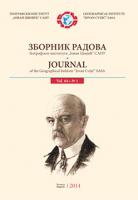The Role Of Human Resources On The Economy: A Study Of The Balkan Eu Member States
The Role Of Human Resources On The Economy: A Study Of The Balkan Eu Member States
Author(s): Dejan Radulović, António Portugal Duarte, Milan Radovanović, Natalia A. Shpak, Darko B. VukovićSubject(s): Education and training, Methodology and research technology, Demography and human biology, EU-Approach / EU-Accession / EU-Development, Human Resources in Economy
Published by: Географски институт »Јован Цвијић« САНУ
Keywords: human capital; economic indicators; NUTS 2; South-Eastern Europe;
Summary/Abstract: In this paper we analyze the impact of the quality of human capital on the main economic indicators of South-Eastern Europe countries [SEE] at the NUTS 2 level. The subjects of this research are the human capital indicators of regional competitiveness. The quality of human capital depends largely on the age structure of the population and the quality of education. Those regions, which have the highest percentage of the working-age population and highly educated people, are able to achieve higher productivity and gain a competitive advantage over other regions. As main indicators of the quality of human capital we identified: population; persons aged 25-64 with tertiary education attainment; students in tertiary education and participation of adults aged 25-64 in education and training and human resources in science and technology. As main economic indicators, we identified: regional gross domestic product; employment and income of households. The aim of this paper is to determine whether there is a correlation between the indicators of the quality of human capital and economic indicators. As a main methodology we have used the correlation coefficient which shows interdependence of the analyzed indicators. As part of our analysis, we consider only EU member states that belong to the SEE countries: Slovenia, Croatia, Romania, Bulgaria and Greece. We conclude that in all countries there is a high multiple correlation coefficient between the indicators human resources in science and technology, number of students and employment.
Journal: Зборник радова Географског института "Јован Цвијић" САНУ
- Issue Year: 65/2015
- Issue No: 2
- Page Range: 253-268
- Page Count: 16
- Language: English

